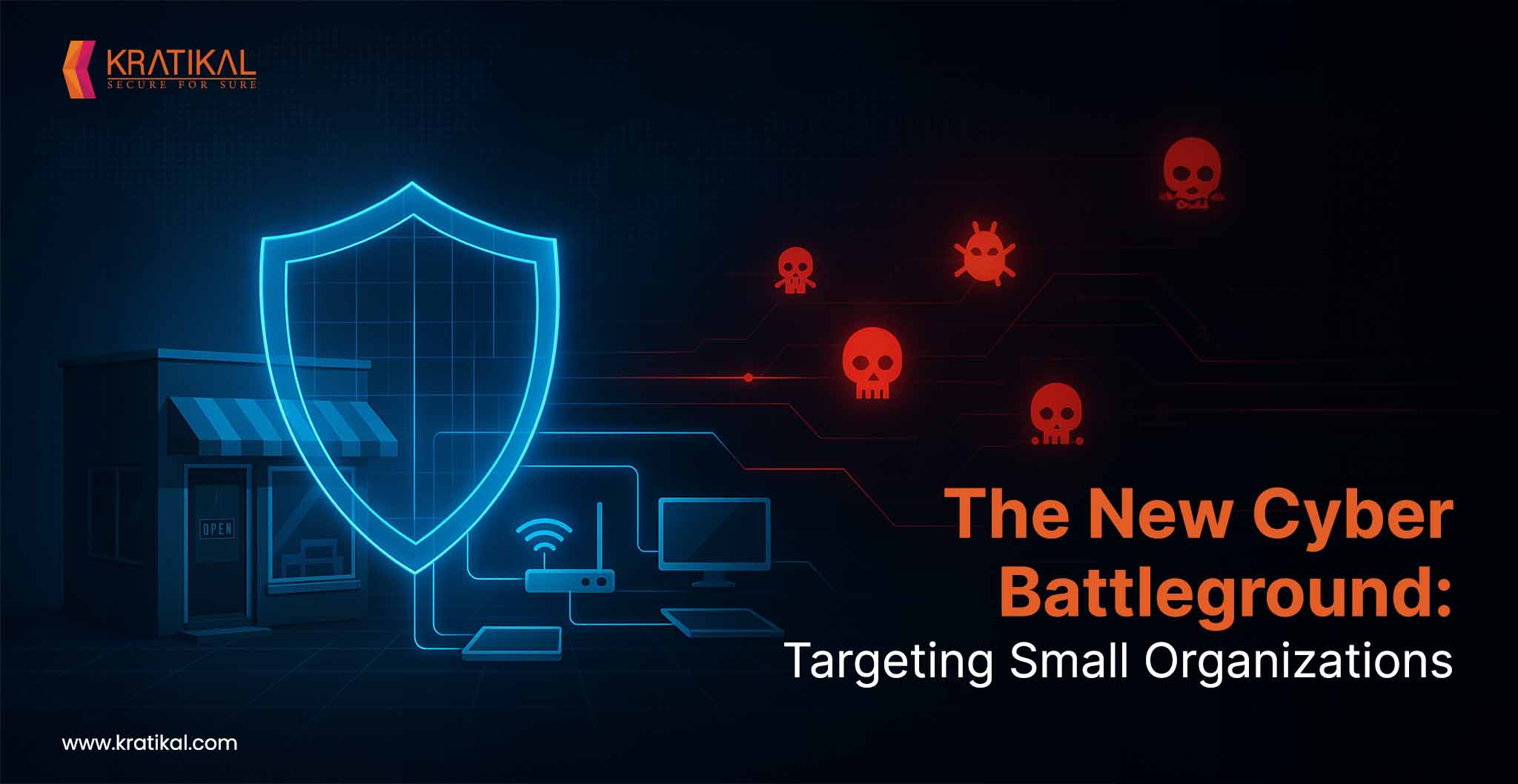Have you noticed the pattern shift in cyberattacks? At the age where the fight for power has advanced to artificial intelligence, the targets for some of our enemies have shifted elsewhere! Hackers that once focused on large enterprises now routinely strike small businesses, nonprofits, and local governments. Why scoop low? If you are on the investigating side, then this is the angle you must focus on! The 2025 Verizon Data Breach Investigations Report notes that cyberattack on small organizations are nearly four times more often than large ones. It reflects a troubling reality: hackers view small organizations as attractive, low‑hanging fruit.
Table of Contents
Cyberattack on Small Organizations: Threat Landscape
Several recent studies paint a sobering picture for small business owners. Verizon’s 2025 DBIR highlights that stolen credentials remain a primary vector; 88 % of basic web application breaches involve stolen credentials, and ransomware is present in 75 % of system‑intrusion breaches. Meanwhile, the 2024 FBI Internet Crime Report records 263,455 cybercrime complaints, causing US$1.571 billion in losses. Ransomware remained the most pervasive threat to critical infrastructure sectors, with complaints increasing by 9% over the previous year.
The FBI recorded 193,407 phishing complaints in 2024, resulting in losses of approximately US$70 million, while industry estimates suggest 3.4 billion phishing emails are sent each day. During May 2025, BEC attacks spiked 48 %, with bad actors often cashing out through gift cards (25.2 %) or credential phishing (23.2 %). Guardz’ 2025 report revealed that weekly cyberattacks on small businesses nearly doubled compared with the first half of 2024 and that over 80 % of these attacks targeted account credentials.
Book Your Free Cybersecurity Consultation Today!
Cyberattack on Small Organizations: The Cost of Recovery
Sophos’ State of Ransomware 2024 found that 59 % of organizations were hit by ransomware in 2023; average recovery costs (excluding ransom) rose to US$2.73 million, a 50 % increase from the previous year, and average ransom payments increased fivefold to US$2 million. The FBI recorded 3,156 ransomware complaints in 2024 with reported losses of US$12.5 million; nearly half (47 %) of small businesses surveyed said they had been hit by ransomware.
Data from the DeepStrike Cyber Attacks on Small Businesses 2025 report highly underscores the scale of the problem: global ransomware incidents increased 11 % in 2024, while the Anti‑Phishing Working Group recorded 933,000 unique phishing attacks in Q3 2024. Verizon’s DBIR reports that the median loss for ransomware and BEC incidents is US$46,000, with 60 – 70 % of small business victims losing critical data and experiencing downtime of more than a day.
Cyberattack on Small Organizations: Perceptions vs. Preparedness
Despite the rising threat, many small firms remain underprepared. An AI in Cybersecurity survey cited by ConnectWise found that 83 % of small and medium businesses (SMBs) believe artificial‑intelligence technology has increased the cyber threat level, yet only 51 % have implemented AI‑specific cybersecurity policies. Budgets are increasing; 58 % spent more on cybersecurity in 2024, and 57 % now view cybersecurity as their top priority, but confidence is low! 73 % of SMB leaders lack confidence in their managed service providers.
Another Risk Barometer review reveals that 41 % of US small businesses experienced a cyberattack, rising to 72 – 73 % for Canadian SMBs and nearly 50 % for U.K. firms. The average cost of a breach for companies with fewer than 500 employees was US$3.3 million, while the median breach cost reported by the U.S. Small Business Administration was US$8.3K. These numbers highlight the financial vulnerability of small enterprises.
Cyberattack on SMBs – The Human and Business Impact
- An Emerson survey of small business owners found that 60% of SMBs that suffer a cyberattack shut down within six months.
- The average total cost of a cyberattack on an SMB was US$254,445, with some incidents exceeding US$7 million.
- Only 17 % of small businesses have cyber insurance.
- Half of the surveyed firms take at least 24 hours to recover from an incident, and 40 % lost important data.
- Despite these risks, only 23 % of SMB owners feel prepared for a cyberattack, even though 60% consider cybersecurity a top concern.
- Less than half have implemented multi‑factor authentication (MFA) or provide regular cybersecurity training, and a quarter still believe they are too small to be targeted.
Cybersecurity for Small Organizations: Building Resilience
Small organizations can significantly reduce their risk by adopting a multi‑layered approach. The following best practices are drawn from CISA recommendations, NIST guidelines, and lessons from the case studies.
Strengthen the Human Element
- Provide regular training. Employees should learn to recognize phishing emails, suspicious links and social engineering tactics. Include training on new threats, such as deepfake audio or AI‑generated phishing.
- Establish a security culture. Encourage employees to report suspicious activity without fear of blame. Reinforce the idea that cybersecurity is everyone’s responsibility.
- Promote awareness of social‑engineering threats. Business email compromise often occurs when staff are rushed or distracted. Implement verification procedures for wire transfers and changes to payment details.
Implement Strong Access Controls
- Use multi‑factor authentication (MFA). Attackers frequently leverage stolen credentials. Enabling MFA on email, banking and cloud services adds a critical barrier. According to Emerson’s survey, less than half of small businesses have deployed MFA.
- Follow the principle of least privilege. Restrict access to sensitive systems and data to only those employees who need it. In the NIST case, unauthorized access to banking systems contributed to the scale of the theft.
- Regularly change passwords and monitor access logs. Use password managers to enforce strong, unique passwords.
Maintain Robust Technical Defenses
- Keep systems patched and up to date. Unpatched vulnerabilities contributed to 14 % of breaches. Conduct VAPT regularly and prioritize critical updates.
- Deploy endpoint protection and firewalls. Modern AI-powered pentest and VMDR platforms leverage behavior analysis to detect vulnerabilities and prioritize risk remediation.
- Implement network segmentation. Limit the probability of breaches by separating critical systems from less sensitive networks. For industrial control systems, minimize internet exposure and use secure gateways.
- Backup data offline. Maintain offline or immutable backups and regularly test restoration procedures.
Prepare and Plan
- Develop an incident response plan. Outline roles, communication protocols and recovery steps. Practice tabletop exercises to ensure readiness.
- Set up transaction alerts and monitor accounts. Banks often provide real‑time alerts for unusual activity.
- Assess cyber insurance options. Although only 17 % of small businesses currently have cyber insurance, policies can help cover recovery costs and provide access to incident response experts.
- Regularly conduct risk assessments. Identify your organization’s crown jewels and assess the potential impact if they were compromised. Use compliance frameworks like NIST’s Cybersecurity Framework, ISO 27001, GDPR, DPDP, and others to ensure there is no violation of rules.
Get in!
Join our weekly newsletter and stay updated
End Note
As hackers continue to shift their focus toward small and mid-sized businesses, one truth stands out, cyber resilience is now a survival mechanism. Every phishing email ignored, every outdated system left unpatched, and every untrained employee represents an open door for hackers. But the good news? Small organizations can still turn the tide. You can invest in people through regular awareness and training, strengthen processes with clear incident-response plans, and deploy advanced vulnerability management and scanning platforms. The organizations that turn cybersecurity from ‘following-the-trend’ into a culture will not just survive the new battleground… they’ll win against the cyberattack on small organziations!
FAQs
- Why are small businesses increasingly targeted by hackers?
This is because they often have weaker security and fewer resources. Many don’t use multi-factor authentication or update systems regularly, making them easy targets for quick attacks like ransomware.
- What is the average cost of a cyberattack on a small business?
On average, a cyberattack costs around US$250,000, though some can reach millions. Losses also come from downtime, legal issues, and damaged reputation.
- How can small businesses protect themselves from ransomware?
Use multi-factor authentication, keep systems updated, back up data regularly, and train employees. Have a clear response plan to recover quickly without paying ransoms.








Leave a comment
Your email address will not be published. Required fields are marked *